|
 Tamil Nadu Election Results 2011: DMK-Congress defeat in Tamil Nadu shows corruption a major issue,says BJP
Tamil Nadu Election Results 2011: DMK-Congress defeat in Tamil Nadu shows corruption a major issue,says BJP
The Bharatiya Janata Party (BJP) Friday said the drubbing of the DMK- Congress alliance in Tamil Nadu was one of the worst defeats and showed that corruption was a major issue.
"The Congress-DMK alliance has suffered its worst defeat in Tamil Nadu. This is the big lesson. This shows that corruption is definitely an issue," BJP spokesperson Prakash Javadekar said.
"Politics in India is state-specific. People are voting locally and we are trying to analyse nationally what is creating problems. The reality is that every state votes according to its priorities, issues, social combination and leadership," Javadekar told news channel NDTV, adding that in Tamil Nadu corruption, especially the 2G scam impact, was felt by the ruling party.
He was referring to the fact that the DMK's A. Raja, a former central communications minister, is behind bars in the 2G spectrum scam. Its MP and Chief Minister M. Karunanidhi's daughter Kanimozhi has been name co-conspirator in the multi-million rupee scandal and could land in more trouble with the Enforcement Directorate and the Income Tax department questioning her over the scam.
Javadekar also said the Left's rout in West Bengal and Kerala has now shown that there would now be only the Congress and BJP to fight the polls.
He said there were earlier three political factions - the third front under the leadership of Left Front, a Congress-led alliance and BJP-led coalition. "But now that space has gone and now there will be only two alliances" - one led by the Congress and one by the BJP, he added.
However, he refused to comment on the party's performance in Assam, where the Congress was set for an enviable hat-trick with the main opposition Asom Gana Parishad (AGP) and the BJP crushed.
"What happened to AGP? Did they get the Muslim votes? No, but they lost the advantage of being in alliance with the BJP. So, it was AGP, which was ruled out the alliance," he said.
Referring to Bihar, where the BJP is part of the ruling alliance with the Janata Dal-United (JD-U), he said: "The BJP and JD-U have got tremendous amount of Muslim votes because per se Muslims will vote on performance and they are ready to vote for BJP, not only in Gujarat but even in Bihar and elsewhere."
Both the AGP and BJP party unit chiefs in Assam were trounced.
Javadekar also took pot shots at the Congress over the Kerala results.
"Congress had a lead of 100 seats in Loka Sabaha elections is Kerala, but they are reduced to 65-70 because of the irresponsible utterances about the age of (Chief Minister V.S.) Achuthanandan by Rahul Gandhi," he said, referring to the Congress general secretary's comments on the Kerala chief minister's age. Achuthanandan is 87.
"Congress has come down because there is anger against it but comparatively there is more against the Left. Only in Assam because there was division among the non-Congress voters, it has led comfortably.
"So, we congratulate (Trinamool chief) Mamata (Banerjee), (AIADMK chief) Jayalalitha and those who have won, but definitely Tarun Gogoi has also to be credited for the win," he said.
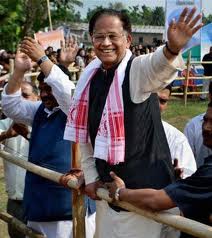 Assam election results: Tarun Gogoi wins for a third time
Assam election results: Tarun Gogoi wins for a third time
Tarun Gogoi is set for an unprecedented third term as Chief Minister of Assam. Today, voters gave his party, the Congress, 76 of the 126 seats in Assam - five more than what the party had in the last Assembly.
Anti-incumbency, says Mr Gogoi, cannot over-rule development."The secret is if you work sincerely, if you work hard for the people. they will repose faith in you...that's what has happened here."
But it's also his firm handling of underground groups like the United Liberation Front of Assam (ULFA) that has convinced Assam that its chief minister is very much a man in charge. Mr Gogoi has shown a fine instinctual understanding of how to negotiate with these groups without capitulating to their agendas.
There's also the fact that the Opposition has done its best to make room for him. The two main parties- the Asam Gana Parishad (AGP) and the BJP failed to strike an alliance, splitting the vote of those who are not Congress-seekers
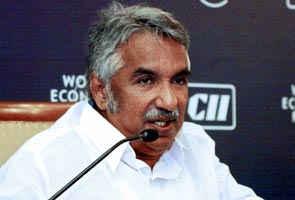 Kerala Election Results 2011: Close race between UDF, LDF
Kerala Election Results 2011: Close race between UDF, LDF
THIRUVANANTHAPURAM: The United Democratic Front ( UDF) is leading in 43 seats, while the Left Democratic Front (LDF) is ahead in 38 seats, according to the early trend for the 140-seat Kerala Assembly.
According to reports, the incumbent Chief Minister VS Achuthanandan is trailing from the Malampuzha seat.
Kerala recorded a turnout of over 74 percent polling.
The other prominent candidates, whose fate will be decided today include, UDF's Chief Ministerial probable Oomen Chandy (Puthupally), KPCC president Ramesh Chennithala (Harippad), CPI(M) polit bureau member Kodiyeri Blakrishnan (Thalassery), Muslim League leader P K Kunhalikutty (Vengara), Kerala Congress (M) supremo K M Mani (Pala) and senior BJP leader O Rajagopal (Nemom).
 Historic win for Trinamool Congress in Bengal
Historic win for Trinamool Congress in Bengal
Assembly elections:
The Trinamool Congress on Friday headed for a historic win in West Bengal, bringing down the curtain on the 34-year uninterrupted rule of the Communist Party of India-Marxist (CPM) led Left Front.
The Left Front - the longest serving Communist-led government in a democratic set-up headed for a rout.
West Bengal chief minister Buddhadeb Bhattacharjee tendered his resignation to Government MK Narayanan at 1.15pm on Friday. He lost his seat and is only the second chief minister in Bengal's history to lose the assembly seat. Prafulla Sen, the third chief minister of Bengal, was the first to lose.
As the state was poised to get its first woman chief minister in Trinamool Congress chief Mamata Banerjee after about 64 years after independence, the defeat of the Left Front spanned almost the entire geographical map of West Bengal.
Its candidates were losing even in erstwhile red citadels like Burdwan, Bankura and Purulia districts and in seats where the coalition had never been defeated since coming to power in 1977.
The Trinamool headed for a landslide bagging 42 of the 294 seats and leading in 144 demolishing the 34-year-old Left citadel in West Bengal in the assembly elections.
Trinamool's ally Congress won 12 seats and was leading in 30.
As per the trends, the Trinamool Congress could form the ministry on its own as the magic figure for government formation is 148.
Left Front major, CPM has so far bagged 13 seats and was ahead in 24.
LF partner, Forward Bloc won three seats and was ahead in nine, while RSP and CPI, two other constituents were leading in 6 and 3 seats respectively.
Independents were leading in two and others in six. Majors Left Front figures including finance minister Ashim Dasgupta, tndustry minister Nirupam Sen, housing minister Goutam Deb and IT minister Debesh Das were trailing.
Trinamool Congress chief Mamata Banerjee dedicated her party's stupendous victory to 'Ma, Mati, Manush' drawing parallels with the freedom struggle and promised good governance, while saying that there would be an end to "autocracy and atrocities".
"Not only in Bengal and India, people across the world were waiting for this verdict and we express our gratitude to all of them," Banerjee said.
Accepting the poll verdict, a joint statement by the chief minister and Left Front chairman, Biman Bose described the debacle as 'unexpected'. They, however, said the Left would play the role of a responsible and constructive opposition in the assembly.
 India can do an Abbottabad, says the man behind Agni missile series
India can do an Abbottabad, says the man behind Agni missile series
Mumbai: “We have the technological capability to undertake an Abbottabad-style surgical attack,” a confident Defence Research and Development Organisation chief and security advisor to the Union defence minister Dr VK Saraswat told DNA on the sidelines of his special talk on innovation and technology on Wednesday, National Technology Day, at the Bhabha Atomic Research Centre (BARC).
“As a policy, we do not believe in hot pursuit. But if the policy makers take a call, we have what it takes,” he said. When reminded that the clamour to emulate the US killing of Osama bin Laden in his hideout was on the rise, the man behind the 3,000-km-range Agni missile series said: “We are a functioning democracy with all powers vested in the government. It is ultimately they who have to take a call.”
He also allayed fears of Pakistan’s nuclear armament falling into the hands of rogue elements. “The international community and India are keeping a close watch on this. There are mechanisms in place to ensure this does not happen. We also have a treaty in place between India and Pakistan to the effect that both countries will keep each other abreast of any untoward development, at and with their nuclear facility, which could have an impact on each other or the region,” he said. (READ: Is Indian Army capable of doing an Abbottabad to nab India's most wanted?)
He also spoke of the impact of recent developments on research. “Our main challenge is developing technology for sustained low intensity conflicts. After the Mumbai attack, we are factoring in the presence of dense population in urban scenarios,” he said.
When asked about the light combat aircraft (LCA) or the Tejas project, he said: “The order for the first batch of 40 LCAs has already been placed at Hindustan Aeronautics Limited. Final tests for the naval version are on. The navy is looking at procuring at least 50 of them.”
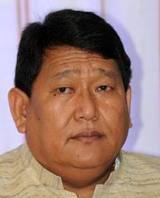 Bodies of Arunachal CM Dorjee Khandu, 4 others, taken to Tawang
Bodies of Arunachal CM Dorjee Khandu, 4 others, taken to Tawang
Itanagar: The Indian Army, with the help of locals, today brought the bodies of Arunachal Pradesh chief minister Dorjee Khandu and four others from Keyla, where the helicopter with five on board crashed on Saturday last.
All the five bodies have been brought to Luguthang and air-lifted to Tawang by an army helicopter, according to sources in the chief minister's office.
Keyla is located at an altitude of 4,500m, about six-hour trek on foot from Luguthang Gompa in Tawang district.
The autopsy of the bodies would be conducted at Tawang Army post at 12.30pm, the sources said, adding Khandu’s body would be brought to Itanagar later this evening.
It would be kept at his official bungalow here for the public to pay their last respects.
Khandu's last rites would be performed at his native village in Tawang, the sources added.
The B3 single-engine and four-seater copter went missing with Khandu, his security officer Yeshi Chodak, Yeshi Lhamu, sister of Tawang MLA Tsewang Dhondup and two pilots after taking off from Tawang helipad and crashed in bad weather in the mountains.
After a five day search, their bodies and the wreckage were located at Kyela yesterday.
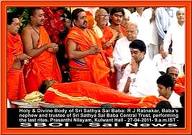 Satya Sai Baba Passes away: Last sites on wednesday
Satya Sai Baba Passes away: Last sites on wednesday
-Lakhs of devotees paid tributes to the saibaba.
-Prominent personalities of India reached at the Puttapathi to pay their homage including Prime Minister Manmohan Singh, President Pratibha Patil,Sonia Gandhi & Sachin Tendulkar.
-India needs one Satya Saibaba for every town/village to provide the best Medical, Education & Civic amenities to the poorest of the poor - Metromirror.com
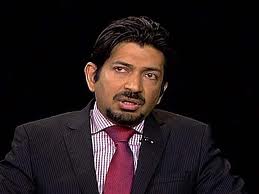
Indian doctor's book an cancer wins Pulitzer prize - Dr. Siddhart Mukharjee, anewdelhi born oncologist has been awarded a Pulitzer prize for his book "The Emperor of all Maladies : A biography of Cancer"
Profile
Birthday / Age : Born in 1970 (Age as on 2011 is 41).
• Birthplace: Delhi, India.
• Recent Address: America.
• Nickname of Professor Dr. Siddhartha Mukhopadhyay: Sidd.
• Education Qualification of Professor Dr. Siddhartha Mukhopadhyay: Pulitzer Award Winner Siddhartha Mukhopadhyay completed his schooling from St. Columbus School in Delhi and admitted at Stanford College. Later joined Harvard Medical School with the help of Roads Scholarship.
• Profession Occupation of Pulitzer Award Winner Siddhartha Mukhopadhyay: Professor of Columbia University in New York, Researcher and Cancer Specialist. Siddhartha Mukhopadhyay also writes articles for ‘The New England Journal Of Medicine’, ‘The New York Times’.
• Family of Professor Dr. Siddhartha Mukhopadhyay: Pulitzer Award Winner Professor-Dr. Siddhartha Mukhopadhyay lives with his wife Sarah J and two daughters (named Riya and Lina) in America and his father (Shibeswar Mukhopadhyay) mother (Chandana Mukhopadhyay) lives at Safdarjang Enclave in Delhi, India.
• Name of the Book for which Siddhartha Mukhopadhyay won Pulitzer Award in 2011 is The Emperor of All Maladies: A Biography Of Cancer.
Other Indian Personnel who had won Pulitzer Award before are Gobinda Bihari Lal (1937), Jhumpa Lahiri (2000) and Gita Anand (2003. Siddhartha Mukhopadhyay is the fourth Indian to win Pulitzer Award in 2011.
Congratulations to Dr. Siddhartha Mukherjee for his work and achievement and good wishes for upcoming medical projects of Dr. (Prof) Siddhartha Mukherjee (Mukhopadhyay).
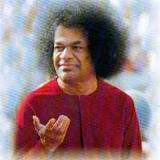
-Satya sai Baba's condition is stable
-Satya Sai Baba -
The Ratnakaram Raju Family
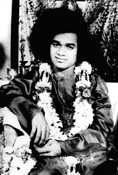 The
Raju family of Puttaparthi was noted for its piety since the
days of the renowned sage, Venkavadhootha, a saintly ancestor
who was looked upon as a Guru in hundreds of villages around.
Not only did the family build and endow the Gopalaswami Temple
(dedicated to Lord Krishna), but Sri Ratnakaram Kondama Raju,
the grandfather of Bhagawan's physical frame, dedicated a
temple to Sathyabhama, consort of Lord Krishna, a deity to
whom this type of homage is seldom offered in any part of
India. Peasants by vocation, they were known for their musical
and dramatic talent and were much involved in the propagation
of the sacred scriptures through village plays and musicals.
Consequently, the family was given the name ‘Bhat Raju’
(Bhat – priest). The
Raju family of Puttaparthi was noted for its piety since the
days of the renowned sage, Venkavadhootha, a saintly ancestor
who was looked upon as a Guru in hundreds of villages around.
Not only did the family build and endow the Gopalaswami Temple
(dedicated to Lord Krishna), but Sri Ratnakaram Kondama Raju,
the grandfather of Bhagawan's physical frame, dedicated a
temple to Sathyabhama, consort of Lord Krishna, a deity to
whom this type of homage is seldom offered in any part of
India. Peasants by vocation, they were known for their musical
and dramatic talent and were much involved in the propagation
of the sacred scriptures through village plays and musicals.
Consequently, the family was given the name ‘Bhat Raju’
(Bhat – priest).
Sri Kondama Raju was a pious soul who lived
out his hundred and ten years of earthly existence in the
unceasing contemplation of the Lord. His wife Srilakshmamma
predeceased him by twenty years. They had two sons who were
both named after Sage Venkavadhootha - Pedda Venkama Raju
and Chinna Venkama Raju. Pedda Venkama Raju, the elder son,
was married to Easwaramma, daughter of Sri Meesaraganda Subba
Raju of Kolimigundla of Kurnool district. Pedda Venkama Raju
and Easwaramma were blessed with a son and two daughters in
that order, Seshama Raju, Venkamma, and Parvathamma.
 Some
years passed and Easwaramma longed for another son. She prayed
to the village gods, performed Sathyanarayana Puja and observed
a number of rigorous vows. One day, an extraordinary incident
occurred that heralded the descent of the divine into her
womb. Easwaramma had gone to the village well to draw water.
There, she noticed a strange bluish glow that transformed
itself into a luminous orb. The ball of light then glided
towards her and entered her being. Shortly thereafter, to
the joy of her family, Easwaramma found herself in the family
way. Some
years passed and Easwaramma longed for another son. She prayed
to the village gods, performed Sathyanarayana Puja and observed
a number of rigorous vows. One day, an extraordinary incident
occurred that heralded the descent of the divine into her
womb. Easwaramma had gone to the village well to draw water.
There, she noticed a strange bluish glow that transformed
itself into a luminous orb. The ball of light then glided
towards her and entered her being. Shortly thereafter, to
the joy of her family, Easwaramma found herself in the family
way.
Divine
Portents
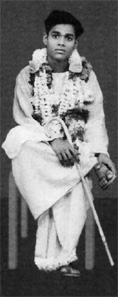 After
a while, mysterious indications of the impending incarnation
occurred in Pedda Venkama's house. For example, there was
the twang of the tambura! Since the brothers and the father
were all interested in the village operas, there was a big
tambura (a string instrument) and a maddala (drum). As the
birth of the son for whom Mother Easwaramma prayed, announced
itself as imminent, the house was awakened at midnight, and
sometimes even later, by the tambura twanging automatically,
and the maddala beating rhythmically as if an expert Hand
was playing on it! One Shastri (Vedic scholar), whom Pedda
Venkama Raju approached for an explanation, said that it was
an auspicious occurrence: it meant the presence of a Shakthi,
a beneficent Power, conferring harmony, spiritual elevation
and joy. After
a while, mysterious indications of the impending incarnation
occurred in Pedda Venkama's house. For example, there was
the twang of the tambura! Since the brothers and the father
were all interested in the village operas, there was a big
tambura (a string instrument) and a maddala (drum). As the
birth of the son for whom Mother Easwaramma prayed, announced
itself as imminent, the house was awakened at midnight, and
sometimes even later, by the tambura twanging automatically,
and the maddala beating rhythmically as if an expert Hand
was playing on it! One Shastri (Vedic scholar), whom Pedda
Venkama Raju approached for an explanation, said that it was
an auspicious occurrence: it meant the presence of a Shakthi,
a beneficent Power, conferring harmony, spiritual elevation
and joy.
The Advent
23rd of November, 1926, the Hindu year of
Akshaya, meaning, the Never-declining, the Ever-full. It was
the time of sunrise and the villagers were chanting the names
of Lord Shiva, remembering that the day was still Karthika
Somavara, a Monday of the Holy Month of Karthika, devoted
to the puja (worship) of Shiva. That day was made even more
auspicious for Shiva worship, because the ascendant star was
Ardra (the star of Shiva). On this day, when these rare and
propitious signs came together, the people thronged the temples
of the Lord to offer special pujas and pray for His benediction.
The Mother had also just finished her Sathyanarayana
Puja in accordance with her vows, for, even while she
was going through the final rituals, the pangs forewarned
her. When Easwaramma announced the pangs, word was sent to
the mother-in-law, Lakshmamma, the pious lady of the house;
but, it became known that she had gone to the house of the
priest to perform the Puja of Sathya Narayana; the messenger
discovered her there and urged her to return; but she was
so confident of the Grace of Lord Sathyanarayana, so steadfast
in her devotion, so disciplined in her religious adherence,
that she refused to be hustled!
She sent word that she would bring with her
the sacred offerings after the Puja and that on no account
would she allow her prayers to be interrupted! She finished
the entire ritual with full concentration, came home and gave
her daughter-in-law the flowers and the sacred water. Easwaramma
partook of the blessings of the Lord. Next moment, the Lord
was born and the Sun rose above the horizon!
The Divine Child
A very significant event occurred soon after
the birth of the child, which revealed the divinity of the
baby. One day, it was noticed that the bed of clothes on which
the baby was lying was being moved up and down in a peculiar
way by something underneath. They watched with bated breath
and when they looked under the bed they found a cobra underneath!
The snake was playing the role of Sesha to the Seshasai! [Sesha,
according to Hindu belief, is the serpent on whose bed of
coil Lord Vishnu rests.
The baby was named Sathyanarayana because
there seemed to be a significant relationship between the
worship to that God and the realisation of the mother's cherished
desire. When the Namakaranam (Naming Ceremony) was performed
and the name was whispered in the ear; it seems the baby smiled,
for the suggestion to give that name must have emanated unobtrusively
from Itself! The embodiment and exponent of Truth could not
give Himself a more appropriate name.
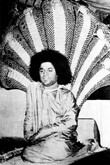 The
little “Brahmajnani” The
little “Brahmajnani”
Little Sathya soon became the pet of the
entire village of Puttaparthi and the farmers and cowherds
vied with each other in fondling it and feeding it and playing
with its lovely silken curls. Its charming smile attracted
every one. Like a lighted lamp, Sathya moved about the house
and laughter tinkled in the street when He lisped His sweet
vocabulary of sounds.
The villagers soon started referring to
Him as “Brahmajnani”, the knower and proponent
of Brahman or Godhood. Even at a young age, Sathya was known
for His extraordinary love and compassion towards creation
and aversion towards harming any creature. His heart melted
at human suffering. Whenever a beggar appeared at the door
and raised his cry, Sathya abandoned His play and rushed in,
to force His sisters to dole out grain or food. The elders
in the house tried to dissuade Him saying, "Look here!
You may give him food; but, mind you, you will have to starve."
That did not daunt the child; He used to run inside and bring
food to the hungry man at the door; and stay away from dinner
or lunch, himself. Nothing and nobody could persuade Him to
come to His plate, which was left untouched!
While others in the family relished non-vegetarian
food, little Sathya would advise them to desist from such
cruel habits. Whenever such food was cooked in the household,
the boy used to run to the Karnam's (village chief) house,
and partake of the food offered by Subbamma, the aged lady
residing there, for they were Brahmins and vegetarians.
So distinct was His behaviour that a wag
once nicknamed Him "the Brahmin child"! Yes, it
was a fitting description. Little did that wag know that,
while in the previous body, this child, so laughed at now,
had declared at Shirdi, "This Brahmin can bring lakhs
of men on the White path and take them to their destination!"
The early school days
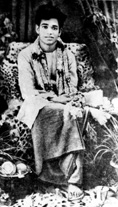 At
the age of eight, Sathya was declared fit to proceed to the
Higher Elementary School at Bukkapatnam, about two and a half
miles from Puttaparthi. He had to start early, after a meal
of cold rice and curds or cooked ragi (maize), rice and chutney,
carry the afternoon meal in a bag, and with His companions
make the arduous trek daily to Bukkapatnam. At
the age of eight, Sathya was declared fit to proceed to the
Higher Elementary School at Bukkapatnam, about two and a half
miles from Puttaparthi. He had to start early, after a meal
of cold rice and curds or cooked ragi (maize), rice and chutney,
carry the afternoon meal in a bag, and with His companions
make the arduous trek daily to Bukkapatnam.
Sathyanarayana was a precocious child, learning
more things than anyone could teach Him and much quicker than
most; He could sing all the songs and Stotras (prayers) that
were recited at the village operas. He even composed at the
tender age of seven or eight, some touching songs for the
cast, which were gladly accepted by them for public presentation!
The Pandhari Bhajan group
When He was about ten years of age, Sathya
formed a 'Pandhari Bhajan' group in the village of Puttaparthi.
The group consisted of about sixteen to eighteen boys dressed
uniformly in ochre clothes, holding each a flag in the hand
and wearing jingling anklets. They all danced to the tune
of folk-songs and ballads, describing the yearning of pilgrims
for Lord Panduranga's Darshan. He also added some Bhagavatha
songs of His own. It was noticed that He added to these traditional
themes, songs on a pilgrimage to a new shrine of which no
one had heard, and the majesty of a new Deity of whom they
had not even the faintest idea, Shirdi and Sai!
Moreover, it was observed that when an infection
of cholera swept like a poisonous miasma over the area and
wiped out entire families in the surrounding villages, Puttaparthi
did not feel the blast of death. Wise men told one another
that the Divine Atmosphere generated by the Bhajan group was
responsible for saving their lives.
At Kamalapuram
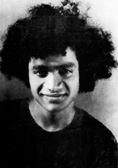 Sathya
had to move to Kamalapuram, a small town about 200 kilometres
from Puttaparthi, with His brother Seshama Raju. His parents
planned to give Sathya a college education, so that He may
become an officer! And hence, they were prepared to part with
their beloved son and send Him to Kamalapuram to the Board
Middle School there, so that His studies could be continued. Sathya
had to move to Kamalapuram, a small town about 200 kilometres
from Puttaparthi, with His brother Seshama Raju. His parents
planned to give Sathya a college education, so that He may
become an officer! And hence, they were prepared to part with
their beloved son and send Him to Kamalapuram to the Board
Middle School there, so that His studies could be continued.
Sathya was a quiet, well-behaved boy and
the favourite of His teachers. Once, He sang the prayer song
before the curtains went up on a drama in the town and those
who heard His sweet voice spread the news that a 'fine musician'
had come to town. Prayer songs at functions like public meetings
became His monopoly thereafter.
A merchant by name Kote Subbanna who sold
medicines, tonics, glassware, umbrellas, etc. came to know
of Sathya’s talents and approached Him for a ditty to
market his new product. He gave Him the necessary information
and by evening, Sathya was ready with an attractive Telugu
song, which was sung in chorus by His friends and Him. They
used to march along the streets, with placards in their hands,
singing Sathya’s slogan-filled jingle and evidently
enjoying their task!
A word may be said about Sathya and His involvement
in the theatrical activities at school. Sri Thammi Raju, the
teacher in-charge, once asked Sathya, who was only twelve
years old then, to produce a play in Telugu. Sathya plunged
into the work very enthusiastically. The drama was a great
success, not only because the hero of the play was a little
boy, a role enacted by Sathya himself, but, chiefly because
it had as its theme the eternal sin of man – hypocrisy.
The title of the play was "Cheppinattu
Chesthara?" meaning "Do we practise what we
preach?"
Meanwhile, Seshama Raju was transferred to
Uravakonda. He decided to take Sathya along with him with
the intention of admitting Him at the Sri Karibasavaswami
District Board High School there. Accordingly, Sathya accompanied
His elder brother to continue His studies at Uravakonda. The
town of Uravakonda would be witness to the grand and mysterious
events that would mark the momentous transformation of the
young child into a great spiritual master who would change
the very destiny of mankind.
Mysterious Turn of events at Uravakonda
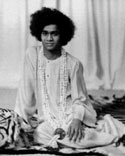 Sathya
was sought after by people who had lost articles of value,
for He had brought with Him to Uravakonda the reputation for
intuitive perception, which revealed to Him the place where
anything was! Baba says that in those days, He used to give
His friends only the first and last letters of the names of
the persons with whom the lost articles could be found. He
left them with their own resources to recover the goods. Sathya
was sought after by people who had lost articles of value,
for He had brought with Him to Uravakonda the reputation for
intuitive perception, which revealed to Him the place where
anything was! Baba says that in those days, He used to give
His friends only the first and last letters of the names of
the persons with whom the lost articles could be found. He
left them with their own resources to recover the goods.
On March 8, 1940, the whole town was shocked
to hear that a big black scorpion had stung Sathya in the
twilight hours of the evening. However, Sathya slept that
night without any sign of pain! Every one felt relieved, only
to become anxious once again when the next evening, Sathya
fell unconscious and became stiff; He would not speak and
breathing appeared faint. Seshama Raju brought in a doctor,
who gave an injection and left behind a mixture. Sathya was
apparently unconscious throughout the night. The doctor came
again in the morning and declared that the boy was out of
danger!
An incident happened in the night which showed
that Sathya was not 'unconscious' but, that He was actually
supraconscious! Some one suggested that the local deity be
propitiated, because the condition of the boy may be due to
some evil spirit that possessed Him. So, volunteers hurried
to the temple and offered worship, placed flowers and incense,
and broke a coconut at the altar. At that very moment, Sathya,
who was to all intents 'unconscious', said, "The
coconut has broken into three pieces," and when
the volunteers came home with the offerings, they had with
them three pieces and not the usual two!
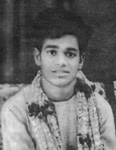 Sathya
got up in a day or two and began to behave in an extraordinary
way. Baba has said that He Himself initiated the process of
manifestation, for He could not wait any longer, playing about
as a mere boy, with 'brother' and 'sister' and 'classmates'
and other secular bonds. He wanted to demonstrate that He
was beyond both ‘Visha’ and ‘Vishaya', that
neither the poison of the scorpion nor worldly attractions
could ever affect Him. Sathya
got up in a day or two and began to behave in an extraordinary
way. Baba has said that He Himself initiated the process of
manifestation, for He could not wait any longer, playing about
as a mere boy, with 'brother' and 'sister' and 'classmates'
and other secular bonds. He wanted to demonstrate that He
was beyond both ‘Visha’ and ‘Vishaya', that
neither the poison of the scorpion nor worldly attractions
could ever affect Him.
Meanwhile, Sri Seshama Raju had informed
his parents at Puttaparthi about the state of affairs at Uravakonda.
He had written that Sathya was not answering anyone who spoke
to Him, that it was a herculean task to make Him accept food,
that He was spending the time mostly in silence but, sometimes
bursting into song and poetry or reciting long Sanskrit slokas
(hymns) and at times, expounding the highest Vedantic philosophy.
The parents took about a week to reach the place, because
of unforeseen and inexplicable difficulties.
Seshama Raju got nervous as to why the parents
had not arrived. He decided to send someone to Puttaparthi
to find out the reason for the delay. But, Sathya interposed
and said, "You need not send for them now, they will
be here in half an hour," and true to His words, they
came in exactly thirty minutes later.
Divine Fortitude
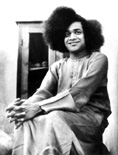 The
parents were beside themselves with worry at the condition
of Sathya; He sang and spoke and behaved in such a queer manner.
It was all so mysterious. At that time, someone gave information
to the worried parents that there was an expert exorcist before
whom no evil spirit dare wag its poison tail! He will cure
Sathya perfectly and make Him fit to go to school, they assured. The
parents were beside themselves with worry at the condition
of Sathya; He sang and spoke and behaved in such a queer manner.
It was all so mysterious. At that time, someone gave information
to the worried parents that there was an expert exorcist before
whom no evil spirit dare wag its poison tail! He will cure
Sathya perfectly and make Him fit to go to school, they assured.
The exorcist was a gigantic figure, terrible
to behold, with blood-red eyes and untamed manners. He tried
all his craft which he dared not experiment even with strong
adult patients! For example, he shaved the head of the boy
and, with a sharp instrument scored three ‘X’
marks on the scalp, from the top towards the forehead. Sathya
sat through the pain without wilting. With the scalp injured
and bleeding with those markings, the witch doctor poured
on the open wound the juice of lime, garlic, and other acidic
fruits.
The parents who were watching the proceedings
in utter despair were surprised, for there was not even a
tear, or a gasp of pain from the boy! But the exorcist was
unrelenting and put the boy through even more terrifying trials
until the parents could bear to see it no more. They wanted
to save the boy from the jaws of that Yama (God of Death)
in human form; they had seen and suffered enough. They paid
him full fees and also gave some unasked gifts, and thanked
him for all the 'learning' he had utilised.
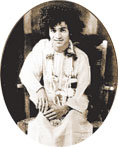 When
asked later as to why He chose to go through this diabolical
adventure, Bhagawan remarked, "Even after seeing
all that fortitude and the miracle of a little boy passing
unscathed through all that terror, even now, you are not convinced
that I am Baba; how then would you have reacted if I just
made the announcement one fine day? I wanted to make known
that I am Divine Stuff, impervious to human suffering, pain
or joy." When
asked later as to why He chose to go through this diabolical
adventure, Bhagawan remarked, "Even after seeing
all that fortitude and the miracle of a little boy passing
unscathed through all that terror, even now, you are not convinced
that I am Baba; how then would you have reacted if I just
made the announcement one fine day? I wanted to make known
that I am Divine Stuff, impervious to human suffering, pain
or joy."
Meanwhile, Sri Krishnamachari, a lawyer-friend
from Penukonda, heard of these occurrences in the Raju household
and came to the village to study the situation and offer what
help he could. He had a good look and told Venkama Raju, “It
is really more serious than I thought; take Him immediately
to the Narasimha Temple (Lord Narasimha – the Man-lion
incarnation of Lord Vishnu) at Ghatikachalam; that is the
last chance". On hearing these words, Sathya said, "Funny,
is it not? I am already there at Ghatikachalam and you want
to take Me to Myself!" The lawyer had no further inclination
to cross-examine.
I am Sai Baba
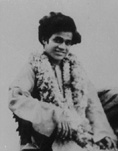 On
23rd May 1940, Sathya rose from bed as usual, but after some
time, He called the members of the household around Him, gave
them sugar candy and flowers taken from nowhere. At this,
the neighbours too rushed in. He gave them each a ball of
rice cooked in milk, flowers and sugar candy concretised by
a mere wave of the hand. Meanwhile, Sri Venkama Raju came
and he was incensed by what he thought was a trick, hiding
things somewhere and producing them by sleight of hand. He
wanted the chapter to be closed before it lengthened into
a tragedy. On
23rd May 1940, Sathya rose from bed as usual, but after some
time, He called the members of the household around Him, gave
them sugar candy and flowers taken from nowhere. At this,
the neighbours too rushed in. He gave them each a ball of
rice cooked in milk, flowers and sugar candy concretised by
a mere wave of the hand. Meanwhile, Sri Venkama Raju came
and he was incensed by what he thought was a trick, hiding
things somewhere and producing them by sleight of hand. He
wanted the chapter to be closed before it lengthened into
a tragedy.
So, arming himself with a stick, he accosted
Sathya and asked, "Are you a God, a ghost or a madcap?
Tell me!" Prompt came the answer, the Announcement, that
had been held back so long, “I am Sai Baba."
At this, Venkama Raju was stunned into silence;
the stick slid from his hands. He stood staring at Sathya
trying to grasp the implications of that announcement - “I
am Sai Baba." But, Sathya continued, “I
belong to Apasthamba Sutra; I am of the Bharadwaja Gothra;
I am Sai Baba; I have come to ward off all your troubles;
keep your houses clean and pure."
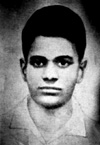 The
elder brother, Seshama Raju went near Him, and asked, "What
do you mean by 'Sai Baba'?" He did not reply, but only
said this much - "Your Venkavadhootha prayed
that I be born in your family. So, I came." The
father felt that Sai Baba was a Muslim spirit speaking through
the boy and so, he asked, "What are we to do with you?”
Prompt came the answer; "Worship Me!"
"When?" "Every Thursday! Keep your
minds and houses pure." The
elder brother, Seshama Raju went near Him, and asked, "What
do you mean by 'Sai Baba'?" He did not reply, but only
said this much - "Your Venkavadhootha prayed
that I be born in your family. So, I came." The
father felt that Sai Baba was a Muslim spirit speaking through
the boy and so, he asked, "What are we to do with you?”
Prompt came the answer; "Worship Me!"
"When?" "Every Thursday! Keep your
minds and houses pure."
One Thursday, someone challenged Sathyanarayana
and asked Him, “If you are Sai Baba show us some proof,
now!" Baba replied, “Yes, I shall"
and asked for some jasmine flowers. With a quick gesture,
He threw them on the floor and said "Look."
They saw that the flowers had formed, while falling, the Telugu
letters, ‘Sai Baba’!
Divine Omnipresence
On an invitation from some townsmen in Hospet,
Seshama Raju decided to take Sathya on a picnic to see if
it might improve the mental health of the boy. Hospet is a
few miles away from the ruins of Hampi, the capital city of
the Emperors of ancient Vijayanagara Kingdom in what is now
the state of Karnataka.
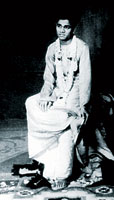 There,
they visited the temple of Lord Virupaksha, the patron deity
of the Vijayanagara royal family. While the others in the
party went into the temple to offer worship at the sanctum
sanctorum, Sathya stood outside admiring the height and majesty
of the Gopuram (tall pyramid-shaped roof of a temple). When
the priest waved the flame of camphor before the Lingam (ellipsoid
structure worshipped as Lord Shiva), they saw to their utter
amazement, Sathya there inside the shrine! He was standing
in place of the Lingam, smiling and accepting their salutations. There,
they visited the temple of Lord Virupaksha, the patron deity
of the Vijayanagara royal family. While the others in the
party went into the temple to offer worship at the sanctum
sanctorum, Sathya stood outside admiring the height and majesty
of the Gopuram (tall pyramid-shaped roof of a temple). When
the priest waved the flame of camphor before the Lingam (ellipsoid
structure worshipped as Lord Shiva), they saw to their utter
amazement, Sathya there inside the shrine! He was standing
in place of the Lingam, smiling and accepting their salutations.
Thinking that Sathya may have slipped into
the shrine evading everybody's notice, Seshama Raju went outside
to verify whether He was still there. Yes, indeed Sathya was
there, leaning on a wall and staring at the horizon! He rushed
inside the sanctum sanctorum and, yet again, he found Sathya
standing there and blessing everybody.
This incident confirmed their faith in Sathya
as a Divine Manifestation. They offered special Puja (worship)
to Him that day. Hospet was on its toes with expectation and
excitement. The story that He was seen as Virupaksha had spread
to that town long before they reached it. The next day He
cured a chronic tuberculosis patient by His touch and made
him get up and walk a mile; He materialized a variety of articles
for the devotees and the enthusiasm of the people knew no
bounds. Bhajan and Namasankirtan (singing the name of God)
continued far into the night.
The
Mission Begins
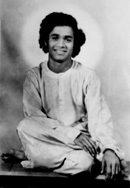 On
the 20th day of October, 1940, the day after they all returned
from Hampi, Sathyanarayana started for school as usual. However,
within a few minutes, He returned to the house. Standing on
the outer doorstep, He cast aside the books He was carrying
and called out, “I am no longer your Sathya.
I am Sai". The sister-in-law came from the kitchen,
only to be blinded by the splendour of the halo around Baba's
head! He addressed her, “I am going; I don't
belong to you; Maya (delusion) has gone; My Bhaktas (devotees)
are calling Me; I have My Work; I can't stay here any longer." On
the 20th day of October, 1940, the day after they all returned
from Hampi, Sathyanarayana started for school as usual. However,
within a few minutes, He returned to the house. Standing on
the outer doorstep, He cast aside the books He was carrying
and called out, “I am no longer your Sathya.
I am Sai". The sister-in-law came from the kitchen,
only to be blinded by the splendour of the halo around Baba's
head! He addressed her, “I am going; I don't
belong to you; Maya (delusion) has gone; My Bhaktas (devotees)
are calling Me; I have My Work; I can't stay here any longer."
When the brother hurried home on hearing
all this, Baba only told him, "Give up all your
efforts to 'cure' Me. I am Sai; I do not consider Myself related
to you".
In spite of repeated pleas, Sathya would
not step into that building again. He moved in into the garden
of the Excise Inspector Sri Anjaneyulu's bungalow, and sat
on a rock in the midst of the trees. People came into the
garden from all directions bringing flowers, fruits, incense
and camphor to worship Him. The garden resonated with the
voices of hundreds singing bhajans (devotional singing) and
following the lines of the first prayer that Sri Sathya Sai
taught them.
“Manasa Bhajare Gurucharanam Dusthara
Bhava Sagara Tharanam “
(O Mind! Meditate on the Feet of the Guru,
which will take you across the wearisome sea of Samsara or
worldly existence.)
A photographer came with a camera to capture
a beautiful picture of the young Swami. He wanted to remove
a crude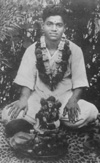 stone that was right in front of Him, but Baba did not heed
to the prayer. He clicked nevertheless and lo! When the photo
was developed, the stone had become an image of Shirdi Sai
Baba!
stone that was right in front of Him, but Baba did not heed
to the prayer. He clicked nevertheless and lo! When the photo
was developed, the stone had become an image of Shirdi Sai
Baba!
A few days later, Baba left Uravakonda for
Puttaparthi. There, He shifted to the house of Karnam (the
village headman) whose aged and devout wife Subbamma attended
on Him with love and affection and welcomed all devotees into
her spacious house; she spared no effort to make their stay
happy and comfortable. Baba often speaks about her dedicated
service, working incessantly from dawn to dusk, cooking and
making other arrangements for the hordes of devotees who began
to land in Puttaparthi every day. As the number of devotees
swelled, a mandir (temple) was constructed in February 1947,
where He began to reside and grant darshan. On 23rd November
1950, Prasanthi Nilayam (The Abode of Supreme Peace) was inaugurated,
which remains till today the central venue for Bhagawan’s
darshan and the festival celebrations that take place in His
Divine Presence.
Sri Sathya Sai Avatar
This was the story of the Advent of the Avatar
and the early years of His life and mission, a mission that
would bring millions to His Lotus Feet to taste the bliss
of Divine Love and thus transform their lives. In a letter
He wrote to His brother Sri Seshama Raju way back in 1947,
Bhagawan emphatically declared the grand purpose for which
He has come.
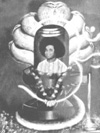 He
said: He
said:
I have a Task: To foster
all mankind and ensure for all of them lives full of Ananda
(Bliss).
I have a Vow: To lead all
who stray away from the straight path, again into goodness
and save them.
I am attached to a Work that I love:
To remove the sufferings of the poor and grant them what they
lack.
I have a reason to be proud,
for I rescue all who worship and adore Me.
The decades that have rolled by since that
epochal letter was written have been witness to the grand
manner in which His vision has taken shape. The world class
super-speciality
hospitals that offer tertiary level medical care free
of charge, schools and colleges that impart values-based education,
the mammoth drinking water supply projects and the numerous
other service projects undertaken by Him stand as a testimony
to His selfless Love and His compassion for humanity. However,
even more significant than these activities have been His
tireless efforts towards spreading the message of spirituality
and inculcating love and brotherhood throughout the world.
Through the Sri Sathya Sai Centers and the Education in Human
Values (EHV) programmes, thousands all over the world have
sanctified their lives by putting into practice His precepts,
and by participating in service programmes such as Narayana
Seva (feeding of the poor) and free medical camps. Truly,
the Sathya Sai Avatar has heralded a Golden era in the history
of mankind.

-Padma Bhushan Anna Hazare to continue hunger strike till Janlokpal Bill is accepted by the India Government
- METROMIRROR.COM readers want Bharat Ratna for Anna Hazare
- MetroMirror.com readers are invited to convey their message for Anna Hazare- Write to: editormetromirror@gmail.com
Readers Reactions:
-I want the India Government to award Bharat Ratna to Anna Hazare for his extraordinary courage to wipe-out corruption from the society-Garima: Broadcast Journalism student, New Delhi
- India needs atleast One Lakh Anna Hazare to build the corruption-less society: Prakriti, Software Engineer, Infosys, Bhubaneshwar
-Madhya Pradesh needs many Anna Hazare to build the Swarnim Madhya Pradesh- Meena, Bank Officer, Bhopal
Who Is Anna Hazare?
Anna Hazare is one of India's well-acclaimed social activists. A former soldier in the Indian army, Anna is well known and respected for upgrading the ecology and economy of the village of Ralegan Siddhi which is located in the drought prone Ahmednagar district of Maharashtra state. The erstwhile barren village has metamorphosed into a unique model of rural development due to its effective water conservation methods, which made the villagers self-sufficient. Earlier, the same village witnessed alcoholism, utter poverty and migration to urban slums. Inspired by Hazare’s unique approach of salvaging a hopeless village, the state government has implemented the `Model Village’ scheme as part of its official strategy. Hazare is now synonymous with rural development in India.
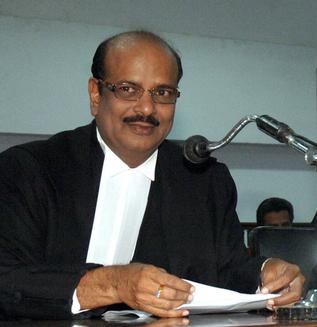 -Justice Dinakaran to face impeachment : -Justice Dinakaran to face impeachment :
16 corruption irregularity & charges levied - Dinakaran to reply by 9th April.
 -Shriram wins indian Idol-5, Rs 50 lakhs, Car and Motorcycle. -Shriram wins indian Idol-5, Rs 50 lakhs, Car and Motorcycle.
 -IIT Graduate gives new identity to the Rupee. -IIT Graduate gives new identity to the Rupee.
 Bank Nationwide strike by their employees demanding higher wages and pensions entered the second day. Bank Nationwide strike by their employees demanding higher wages and pensions entered the second day.
Indian bank strike enters second day, trading hit, Around 900,000 employees announced the two-day strike after talks with Indian Banks' Association,representing the managements of various banks, collapsed earlier this week.
India has 80 commercial banks, including 29 foreign banks and nearly 3,000 urban and rural co-operative
banks.India's state-run banks remained shut on Friday as a nationwide strike by their employees demanding higher wages and pensions entered the second day, hurting volumes in the currency and bond markets.
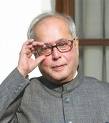 Issue of price rise, We are sensitive to it Issue of price rise, We are sensitive to it
Finance Minister Pranab Mukherjee said. In the Rajya Sabha,issue of price rise of essential commodities
We are sensitive to it,
Intervening in the debate on the issue of price rise.we are responsible (government)... will take measures as and when necessary".While inflation measured by the Wholesale Price Index remained in the negative territory for the eighth
consecutive week ended July 25 to minus 1.58 per cent, essential commodities, particularly food items
like sugar and pulses have seen a sharp increase in prices in the recent weeks.
 Death penalty to 2003 Mumbai blast convicts Death penalty to 2003 Mumbai blast convicts
Mohammed Hanif Sayed, his wife Fahimida and their associate Ashrat Shafique Ansari who were sentenced to
death by a special court Thursday for the 2003 Mumbai twin blasts will join a list of over 300 people on
death row in Indian prisons.
Special Prevention of Terrorism Act (POTA) court Judge M R Puranik today awarded capital punishment to
all the three convicts in the 2003 Mumbai twin blast case.
Pronouncing the order, Judge Puranik said --Ashraf Ansari, Sayed Mohammed Hanif Abdul Rahim and his wife
Fahmida, were awarded death sentence under section-3 (2), (4) of POTA Act and 120 (b) read with 302, 307,
427 of IPC, explosive substance act, prevention of damage act and for murder and attempt to murder.
He said three Lashkar-e-Toiba operatives will be hanged by neck till death for triggering blasts at
various places in Mumbai in 2003 that killed 54 persons and left 244 seriously injured.
The convicts had planted a bomb in bus no 340 at Ghatkopar, that exploped at Andheri bus depot on July
28, 2003 and planted an explosive at Gateway of India and Zaveri Bazar on August 25 the same year.
 Manmohan fill up several vacancies of governors. Manmohan fill up several vacancies of governors.
Prime Minister Manmohan Singh after sworn in Friday for the second consecutive term. will be expected to fill up several vacancies of governors, whose terms come to an end in a few weeks,
Among the governors whose tenures at various Raj Bhavans are coming to end include Nawal Kishore Sharma (Gujarat), S.S. Sidhu (Goa), Balram Jhakar (Madhya Pradesh), S.S. Barnala (Tamil Nadu), Gopalkrishna Gandhi (West Bengal), D.N. Sahay (Tripura), S.F. Rodrigues (Punjab), R.L. Bhatia (Bihar) and R.S. Gavai (Kerala).
“The prime minister will need to take a call soon as this is a big gubernatorial shake-up,” said a senior bureaucrat.
 The Swine flu scare has hit India The Swine flu scare has hit India
The Swine flu scare has hit India. Two London-based NRI, who hails from Delhi, were admitted to Ram Manohar Lohia Hospital here with suspected H1N1 flu symptoms and have been kept under observation in the isolation ward.
He has a running nose, soar throat and cold but has no fever. He will be kept under observation for the next three days
.
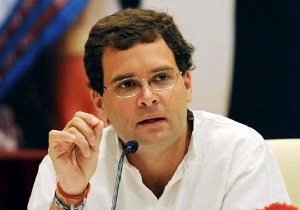 Gujarat is forgetting about the poor people Gujarat is forgetting about the poor people
Gandhi said the Gujarat government has been more concerned about protecting the interests of the business community than helping the farmers and poor people.Gujarat is forgetting about the poor people.
Addressing an election rally Surat, Congress leader Rahul Gandhi claims of Gujarat Chief Minister Narendra Modi that he had propelled the state on the path of development .Gujarat Government has not been sympathetic towards the farming community as no help has been extended to them.He saying his government was more concerned about the business class rather than helping the farmers.Gandhi also slammed the state government for not providing any help to the diamond workers of Surat, but the Centre had given so much money to Gujarat.
Highlighting achievements of the UPA government, Gandhi said it has done so much for the welfare of the downtrodden but wondered whether the benefits reached the poor people.
 Prime minister became the target of a shoe attack Prime minister became the target of a shoe attack
During the current election campaign Prime minister Manmohan Singh became the target of a shoe attack. when an engineering student hurled a sneaker towards him but it fell short of the dais from where he was addressing his first poll rally on sunday in Gujarat at the Tagore hall ground.
Shoe thrower identified as Hitesh Chauhan, a 21-year-old resident of Bapunagar pursuing a computer course in a local engineering college.
Chauhan was sitting on the front row and took out his shoes and was about to hurl it in the direction of the Prime Minister who had just started his speech when security personnel grabbed him.
The shoe fell a few feet away from where the P M was seated. The distance between the security railing and the stage where the P M was seated on the dais was about 30 feet.
The Prime Minister did not want the police to register any case against the shoe thrower. After this incident PM continued with this speech before proceeding to attend another rally.
 Modi's role in Gujarat riots, court orders probe it, Modi's role in Gujarat riots, court orders probe it,
Gujrat Chief Minister Narendra Modi’s role in the 2002 post-Godhra riots,Supreme Court on Monday ordered that investigated.The court sought a report within three months.
A bench of Justices Arijit Pasayat and A.K. Ganguly handed over the investigation of the riots to the Special Investigation Team headed by former CBI director R.K. Raghavan.
It also asked for a probe into the role of senior bureaucrats and police officers during the riots. The court’s order followed a petition filed by Zakia Jafri.
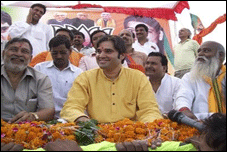 Varun said 'Want to be known by my work, not by Gandhi' Varun said 'Want to be known by my work, not by Gandhi'
BJP leader Varun Gandhi said "People ask me that I am from the Gandhi family and so how do I feel. I tell everyone that I want to be known by my work, not by my name. I want to be seen as 'Gandhi by work', not 'Gandhi by name'.
Gandhi was addressing an election meeting at Fatehpur in Uttar Pradesh. He is contesting Lok Sabha election on a BJP ticket from the Pilibhit constituency in Uttar Pradesh.
Varun Gandhi, who recently triggered a controversy by his hate-speech .He had run into a controversy after he delivered a hate-speech against Muslims during a public meeting in Pilibhit on March 7.
 Rahul would refuse Prime Minister’s post Rahul would refuse Prime Minister’s post
"I do not think I have the experience to be the Prime Minister of the country right now," Rahul Gandhi said at the conference which he held along with External Affairs Minister Pranab Mukherjee in Kolkata.
Rahul said there were two reasons why he could not accept the Prime Minister’s post. "One is that I am working in the organisation of the Congress party, which I think is fundamental for this country. I think it is very important for a strong, progressive, pro-poor youth organisation is developed in this country and that is a very, very big priority of mine.
Rahul said "Manmohan Singh is not from the Gandhi dynasty. He is the Prime Minister.
I am nobody to say whether the doors are open or closed. That is for the party president and Prime Minister to decide. But as a general principle, I can say that doors of Congress.
are open for anyone willing to join us," he said.
 Kasab trial be wrapped up within a month Kasab trial be wrapped up within a month
In a scathing editorial in Saamna, the party mouthpiece, Thackeray said a huge
amount of tax-payers' money has been wasted in providing security to "Kasab
Saheb" (Kasab Sir).
"So much security is not even provided to the country's prime minister. All this
because we want to prove to the world that we are such a strong democracy and
that we will give an opportunity of defence to even those who attack us and
destroy our country," the editorial noted.It urged that the trial be completed within a fortnight to a month; Kasab should
be given punishment against which he cannot appeal in any higher court and the
matter be disposed of.
.
 India achieved another milestone in space India achieved another milestone in space
launch of spy satellite RISAT-2 from ISRO (Indian space research organization) India's spy satellite to eye terrorists, infiltrators. RISAT-2 will keep a round-the-clock vigil on terrorist movements for Fast-tracked.
First-remote sensing satellite with true-blue spying capabilities. It
will be the first ever with the capability to map territory day and night using a
top-secret synthetic aperture radar built by Israel, an upgraded variant of the
TecSAR spy satellite. It can provide high resolution images up to a degree of one
metre. India's own PSLV rocket carried the satellite to space and put it in the
orbit.The top-of-the-line 300 kg spy satellite is a dedicated, all-weather surveillance
tool for India's security establishment. However, the government claims the
satellite will be used for disaster management like predicting floods and
cyclones.
 RISAT-2 radar not a detective sattelite RISAT-2 radar not a detective sattelite
ISRO Cheif G.Madhavan Nair said that RISAT-2 radar not a detective sattelite but scientist agree it's detective. It can provide high resolution images up to a degree satellite will be used for disaster management like predicting floods and cyclones. .
 Prime Minister Manmohan Singh refutes Lalu's charge on Babri demolition Prime Minister Manmohan Singh refutes Lalu's charge on Babri demolition
That's the only fault of the Congress in the demolition of the Babri mosque.
P.M said in Guwahati,. "Kalyan Singh (then UP Chief Minister) gave a solemn assurance to the Supreme
Court (about protecting the mosque). The Congress party certainly can be blamed
because it believed that (Kalyan) Singh will honour his assurance given to the
Supreme Court. But he did not honour it.Replying to questions, Singh maintained that communalism is a "great danger" to
the unity of the country .
Back | 
